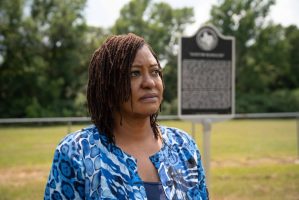By Sarah Whites-Koditschek
As COVID-19 case numbers pick up this winter, too few Alabamians are taking advantage of Paxlovid, a medication that can prevent hospitalization and death in almost 90 percent of cases, state health officials say.
“It saves lives. It prevents serious illness. It prevents hospitalization. It prevents death. It’s highly effective,” State Health Officer Scott Harris said of Paxlovid, a drug produced by the pharmaceutical company Pfizer that, according to Harris, is the best existing treatment against COVID-19.
The state has plenty of the drug in stock, according to Harris. It’s also free to the public. But many people are not taking it, both because they don’t know about it and because some doctors are not proscribing it, he said.
What is Paxlovid?
Paxlovid works by blocking the virus’s ability to spread throughout the body, if taken within the first five days of symptoms. It is considered very safe and has few side effects, experts say.
The CDC recommends the drug for adults 50 and older, and people over the age of 12 with preexisting conditions that make them vulnerable to COVID-19, including a list of conditions ranging from asthma to depression.
Rachael Lee, a professor of infectious diseases at UAB, said Paxlovid can help people feel better faster, reduce symptoms and prevent hospitalization.
“Early diagnosis and early treatment are key here,” Lee said.
“I think from a safety profile (Paxlovid) is a very safe drug. Side effects can include nausea, diarrhea, abdominal pain, and GI related symptoms,” said Lee.
Lee said it is key to get tested as soon as possible. One negative test does not mean you don’t have COVID-19, so she recommends testing again. She said people should contact their provider as soon they test positive so it is possible to get a prescription within the five-day window of the onset of symptoms. If you don’t have a primary care doctor, you can go to an urgent care clinic, she said.
Paxlovid first became available in December of 2021. It is highly effective at preventing hospitalization and death, and it protects against long-COVID, decreasing the likelihood of the condition by about 25 percent, early research shows. An estimated one in five people who contract COVID will experience long-COVID symptoms according to the CDC. According to the CDC, Alabama has the second highest rate of long-COVID in the nation, at 12.1 percent of cases, following Kentucky, at 12.7 percent.
Many aren’t taking Paxlovid
According to data from the CDC, people over age 80, often those at the greatest risk from COVID-19, are particularly unlikely to use the antiviral. Between April and July of this year, less than a third who contracted COVID in that age group used Paxlovid. People over the age of 65 account for about 75 percent of all COVID-19 deaths.
In a survey from by the COVID States Project, only 20 percent of people 65 and older got a Paxlovid prescription once they tested positive for COVID-19 between January and June of 2022.
Alabama has received 124,375 courses of Paxlovid since December, according to U.S. data shared by the Alabama Department of Public Health. State records updated by providers show 17,043 courses of Paxlovid are available on hand as of last week.
According to the health department, as of Wednesday, just 316,263 Alabamians had received the latest bivalent booster shot.
Why isn’t Paxlovid being used more?
Harris said he believes Alabamians are tired of hearing about COVID-19, and the disease not on their radar anymore.
Less than half of Alabamians have gotten any vaccine, and many who only received the first shot are not very protected against current variants, said Harris, who added he is worried about how COVID-19 will play out this winter.
Harris said he hears from pharmacists that few Alabamians are filling prescriptions for Paxlovid. He said often Alabamians don’t know to ask for it once they contract COVID-19.
David Thrasher, a pulmonologist from Montgomery, was at the forefront of treating COVID-19 patients with monoclonal antibodies at the outset of the pandemic. The antibodies are no longer effective for fighting the current strains of the virus, he said. Now Thrasher is aggressive with proscribing Paxlovid, he said. He strongly encourages anyone 50 and older, along with anyone 12 and older who has a risk factor for COVID-19, particularly hypertension, asthma or obesity, to speak to a doctor about whether they can take the drug once they test positive.
Thrasher said he often hears from patients that their providers are reluctant to prescribe Paxlovid. He suspects that’s because of the complexity of vetting dozens of potential drug interactions that can occur with the drugs and the requirement to have information on patients’ liver and kidney function in order to prescribe the proper dose.
Beyond that, many people just aren’t aware of the option.
“You’ve got a new illness not heard of four years ago and new treatments not heard of four years ago,” Thrasher said. “Patients say, ‘I called my doctor, and they say they just don’t prescribe that.’ It’s complicated. It takes time to go over all those drugs.”
Lee, at UAB, said increasing the usage of Paxlovid will require providers to educate themselves. Another key issue is the number of Alabamians who lack access to health care, she said.
Kim Clemmons, a pharmacist with the East Alabama Apothecary, said that much attention was given to promoting vaccination, but she sees less information going around about Paxlovid. That is reflected in relatively low demand at her pharmacy.
“These vaccines have been pushed so much, and they’re everywhere in the news,” she said. “You don’t see as much about the ways to treat COVID. There’s probably not as many people aware.”
Still, a survey of her patients who have received Paxlovid showed over 90 percent completed the five-day course, and the drug was well tolerated. There were very few side effects. Some people had nausea and others experienced a metallic taste.
Chris Harrison, Infectious Disease Clinical Pharmacist at East Alabama Medical Center, said he has yet to see any patients who take Paxlovid progress to a ventilator.
For people who miss the five-day window to seek a prescription and do experience severe symptoms, there are limits to what can be done for them at that point except offer “thoughts and prayers,” said Harrison.
“You hope you don’t advance to the pneumonia phase where it starts attacking your lungs and people have to be admitted to the hospital.”











